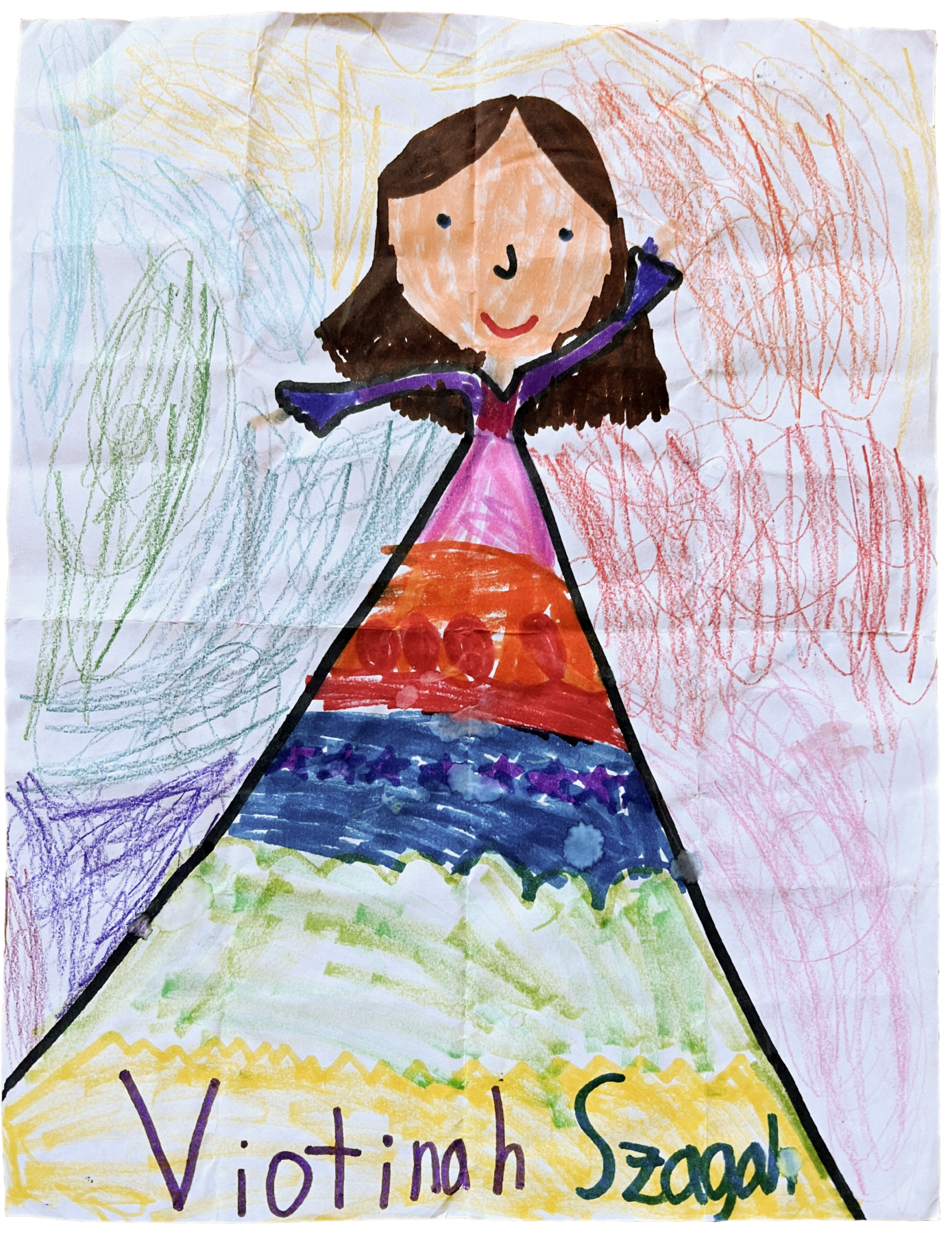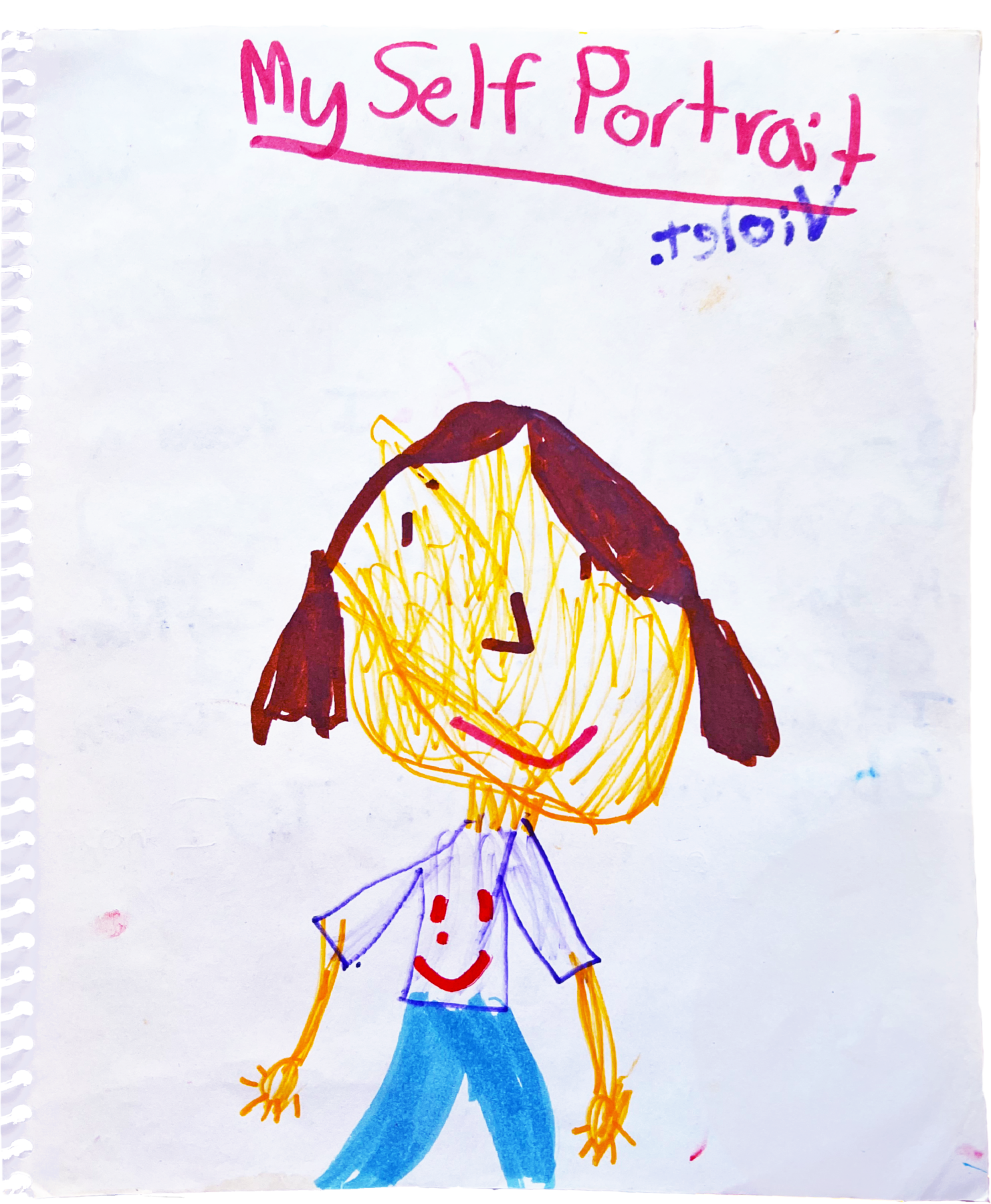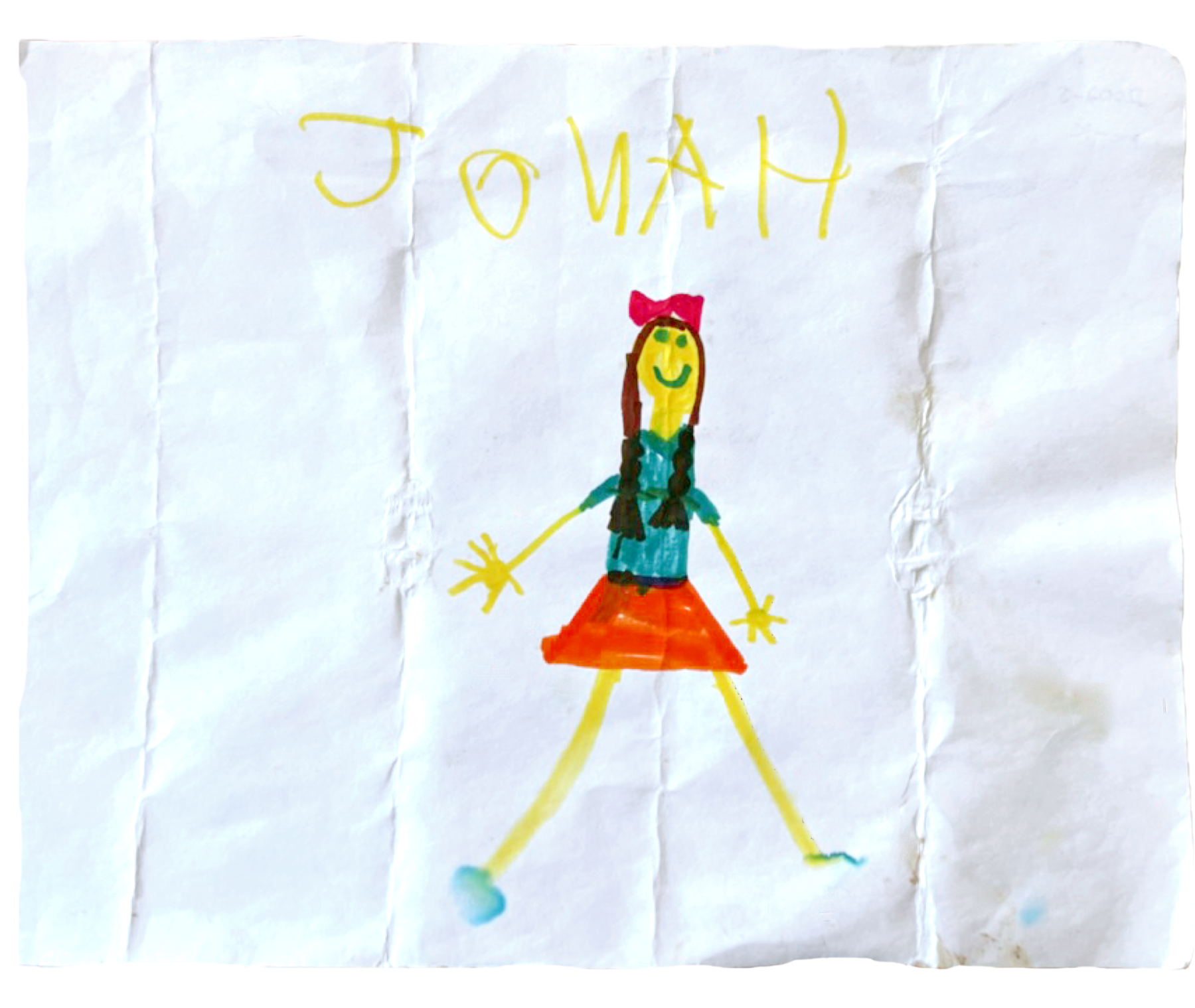
In carefully labeled boxes in her study, my mother preserves my childhood drawings, schoolwork, and journals. Early attempts at academic writing sit inside the Hannah: 2015-2016 bin—“You may just think of Susan B. Anthony as the woman on the silver dollar coin, but she was much more than that.” Hannah: 2013 holds a hand-drawn comic book based on the Clue board game. The boxes before that, dating back to before my transition—all labeled with my birth name—include an evolving set of colorful self-portraits. Each drawing was an attempt to communicate who I was to the world. Each was crafted in Tony Ferraiolo’s Saturday morning drawing group.
Every other weekend starting at age 6, I would walk into the location of Tony’s drawing group in my school clothes. Solemnly, I’d change in the bathroom into whatever feminine outfit I had most recently bought from a secondhand store in Hamden, Connecticut. Sitting around a table covered with scraps of printer paper and loose magic markers, I’d make art with a group of other gender-nonconforming kids from around the greater New Haven area. Tony would give us instructions: “How many of you have been sad about how you relate to your body? Draw it.”
As a kid, I just knew him as the bowler-hat-wearing, tattoo-covered guy who ran my loosely defined art class. But Tony wears many other hats: founder of the Jim Collins Foundation, which provides funding to trans people across America for gender-affirming surgeries; director of the youth and family program for Healthcare Advocates International, a Stratford-based educational and medical organization; guest speaker at countless corporations and groups across Connecticut—a self-described “professional trans person.”
When I began attending Tony’s classes, I never really wondered how or why the program started; I took it for granted that resources like these were available to me. But Tony founded the group in 2008, only a year before I joined. What he offers is a comprehensive but casual program that allows children to express themselves creatively, and, through a simultaneous parent group, provides practical and emotional advice. Through this twofold structure, Tony helps families make sense of their role in their child’s gender journey.

The group evades bureaucratic categorization; it is not housed under any umbrella nonprofit, and there is no official name. Tony even avoids describing the group as his own: “I knew from the beginning that these are not ‘my’ groups, but the members’ groups,” he explained to me. “We don’t have an agenda or a certain subject that the members have to talk about. The support groups are free flowing.” Members can choose the creative activity that they do on a given day, and are free to direct the conversation in whichever direction they please.
Perhaps this casualness is part of why kids like me found so much comfort in the group—it stands apart from well-intentioned but stiff LGBTQ+ info groups at medical centers and Gay-Straight Alliances at high schools, spaces that make self-conscious attempts to tout institutional support but end up stifling vulnerable discussion. But the fact that Tony’s group is separated from larger support structures means that the assistance it offers remains elusive to those not already within the system. No Google search will lead one to this group; it is a resource that travels through the elaborate social network of gender-nonconforming youth and their parents.
But a lack of conventional publicity has not prevented Tony’s group from expanding. Fifteen years after its founding, the program is thriving, with dozens of kids and families attending each week. When I started as a first-grader, I was one of the youngest in the group, shyly watching the teenagers joke around in the room next door; now, there are facilitators and ‘junior facilitators’ (past members who have aged out of the program and want to remain involved) who help Tony manage the larger number of kids. He has split the group into three simultaneous sessions with different activities based on age: drawing time for those under nine, and discussion groups for pre-teens (ten to twelve) and teenagers (thirteen to eighteen). For the last hour of each session, everyone joins together to play board games and socialize.
This independence from a larger institution is part of what has allowed Tony’s classes to continue for so long. Activities hosted by the New Haven Pride Center, for example, have been hampered since the nonprofit lost its 501(c)(3) status for a few months this year after failing to file tax returns. Tony’s group, on the other hand, does not rely directly on institutional support; he offers the Saturday morning meetings pro bono, paying for the craft supplies out-of-pocket. Locations in and around New Haven allow him to use their spaces at no expense for him or the families who attend.
During the years when I was a member of Tony’s class, we bounced around between three locations. Since then, the group has settled down in one place. Tony keeps the meeting location private, he told me when we met in a cafe one February morning, to protect the members of the group. “We have people who hate us.”

When I asked my mom how we first learned about Tony’s group, she described a convoluted chain of contacts. Since my kindergarten days, we had been part of a series of informal groups focused on gender-nonconforming children: a mailing list for parents to share resources (known by its subscribers simply as ‘The Listserv’); a group in New York City that we attended a couple of times the year I was in second grade; and an annual summer family gathering known as Camp I Am. One early liaison from these networks was Edgardo Menvielle, a psychiatrist at the Children’s National Medical Center in Washington, D.C., who put us in touch with a local contact who in turn connected us with Tony.
Perhaps this casualness is part of why kids like me found so much comfort in the group—it stands apart from well-intentioned but stiff LGBTQ+ info groups at medical centers and Gay-Straight Alliances at high schools, spaces that make self-conscious attempts to tout institutional support but end up stifling vulnerable discussion
Others seem to have found out about Tony’s group through similarly elaborate means. As I started working on this article, my mother forwarded me a few of the emails she had received over the last decade from parents of gender-nonconforming youth. Searching through the archives of her inbox, scrupulously sorted just like my childhood artwork, my mom had located dozens of email chains with parents from around Connecticut. Some had gotten her contact information from mutual friends; others knew to reach out to her because they had received the email sent to my whole elementary school when I transitioned. Others were referred to her by local clergy, or physicians who had worked with our family. The parents who reached out to her seemed unable to find these resources on their own; one 2016 email sent to my mom from the parent of a student who had gone to my elementary school read, “Do you know of any social support groups for preteens? I’ve reached out to a couple LGBTQ+ groups and haven’t heard back. We are trying to find anything near New Haven that would be welcoming.” A similar email came from a member of our synagogue. Another was from a professor who had just moved to town. At the end of each chain of correspondence, she would send the concerned parent Tony’s contact info. “He is the connector who holds the community together,” she wrote in one email.
This elaborate network of referrals makes it difficult to trace the origins of Tony’s group—only Tony himself can explain how it began.

When I arrived five minutes early to scout out a table for my meeting with Tony, I found him already there, sitting by the window. He was the same as I remembered him, beard combed into a triangular point, arms covered in sleeves of tattoos that featured, in black lettering on his right arm, the phrase ‘CREATE YOURSELF.’ I, on the other hand, was ten inches taller and six years into hormone replacement therapy. He looked up with a smile, exclaiming, “You’ve gotten older!”
When Tony started the group, he explained, it was easier to find. He announced the proposed meeting times and distributed fliers at True Colors, the annual LGBTQ+ youth conference hosted on the University of Connecticut Storrs campus. At Tony’s first class, only two kids showed up. “One of them, Angel, did the same thing you always did,” Tony laughed, recalling my outfit swaps. “She went to the bathroom and changed into what she wanted to wear. And that’s when I knew that this could really be space to feel comfortable in your skin, create, and be yourself.”
Before 2011, when “gender identity or expression” was added to Connecticut’s list of legally protected categories, there was no requirement that schools respect the identities or needs of gender-nonconforming and trans students. And it wasn’t until 2015 that Yale Health’s Gender Program, a centralized source for trans healthcare in New Haven, was established. Facing a lack of social and medical resources, many families with trans or gender non-conforming children turned to Tony for his familiarity with these issues, and ended up attending his support group.
I, on the other hand, was ten inches taller and six years into hormone replacement therapy. He looked up with a smile, exclaiming, “You’ve gotten older!”
Even nonprofits and medical services that were nominally offering support for queer youth began to refer their patients to Tony, unsure of how to help them navigate other parts of the bureaucracy. “Pretty soon organizations all around Connecticut were contacting me,” Tony said. He would receive open-ended requests from overwhelmed therapists and doctors, who knew him from his public speaking and nonprofit involvement. “We have a 7-year-old, we have a 9-year-old, we don’t know what to do,” Tony recalled them saying. “Can you help?”
The group quickly grew from there. Now, Tony finds publicizing the group unnecessary. He explained that people just know about him, as we had, through the natural social fabric of the LGBTQ+ community. “I always get emails that say stuff, like, ‘a friend of a friend knows a parent that goes to your group,’” described Tony. “Barely anyone knows my last name. People just say—oh, there’s this guy, you know Tony—oh yeah, I know Tony!”

Tony’s strength lies in his ability to simultaneously offer practical and emotional support. When families ask for advice about legal or medical services, he is already familiar with the specific laws and systems that govern Connecticut. When a child is unsure about how to express themself in words, he sits with them and has them draw pictures. And when he needs to help a hesitant parent come around to accepting their child, he meets them where they are.
Tony described one recent interaction on the phone with the father of a child who had come out as trans: “He was dropping the F bomb, cursing his kid out. I said, well, is there any self-harm or any suicidal ideations going on with the kid? ‘Oh yeah. He tried to kill himself three times.’ So I said, let me ask you a quick question. Do you want to accept your son or mourn your daughter? Because there is a likelihood of you standing in front of that grave saying, shit, I should have called you Chris this whole time.”
Tony has seen these stories, all-too-common in the trans community, play out around him; he has witnessed firsthand the effects of children feeling alone. “A few years ago, I was visiting a psych hospital to see a kid…When he saw me, he smiled so big. To me, it felt like at that moment in my life, I was responsible for all these lives.” The weight of providing a child with the love and acceptance that their parents had withheld left Tony physically incapacitated. “My blood pressure went sky high. I had to go to the emergency room.” Tony took a yearlong break from life coaching after this incident.
Helping a child navigate their own gender identity thus requires a complex combination of buy-in and detachment from parents. “I don’t think people realize this enough with kids,” Tony posited, “but no one knows who they are better than they do. I tell parents all the time, allow your child to walk their journey. You just protect them. They know who they are.”

Tony described the types of language he frequently uses with hesitant parents. “I’m not trying to talk you into anything. The only thing I’m trying to do, because of the love you have for your child, is make sure you have a good relationship with them, support them.”
Beyond the myriad of concrete ways he contributes to Connecticut’s LGBTQ+ community, it is these relationships Tony crafts and facilitates that most powerfully transform the lives of those around him. “That’s what I’m here for,” he told me. “I’m here to talk it out.”
So I said, let me ask you a quick question. Do you want to accept your son or mourn your daughter? Because there is a likelihood of you standing in front of that grave saying, shit, I should have called you Chris this whole time.
When I was around nine, I asked Tony to start having one-on-one meetings. I had started to become aware of an identity being forced upon me that felt deeply wrong. During music and gym time, we were now split into “boy” and “girl” groups; in Spanish class, my grammar started to be corrected when I resisted using the masculine ending -o to describe myself. Amidst these curricular shifts, I grappled with the fact that my body was soon going to change in ways I wasn’t sure I could deal with. But I lacked the words to describe exactly what it was I wanted to say.
Tony and I would meet every month or so, on weekday evenings in his Hamden apartment. The walls of his living room were adorned with his own art—abstract and tactile, loose brushwork and dripping colors. It was here in this private space, sketchpad in hand, that I first articulated through drawing that I was transgender. When I didn’t want to talk it out, Tony and I would draw it out.
**A correction was made on May 5, 2023: An earlier version of this article misstated the city in which Healthcare Advocates International operates. It is Stratford, CT, not Hartford, CT.
–Hannah Szabó is a sophomore in Pauli Murray College.

On June 10th at 6:30, at North Branford High School, Tony’s alma mater, there will be a tenth-anniversary screening of the documentary A Self-Made Man, a film by Lori Petchers about Tony’s life and his work with transgender and nonbinary youth and their families The event will benefit Q+, a queer youth organization in Hartford, TV-365, a nonprofit organization serving the transgender community, and North Branford High Schools Diversity Group.
Crayon illustrations by Charlotte Rica.


